1950s Men’s Hairstyles Still on Trend Today
Hairstyles are like the cover of a book. People tend to notice the hair first in the overall appearance of a person. Before the 1950s, hairstyles for men weren’t even a thing as it was considered a female business. It was about to change forever, leaving an impact that still resonates nowadays.
The slick back or side-part style occupied much of the 1920s and 1930s, but the decade of the 1950s brought the revolution to hairstyles for men. They let their hair longer and did all sorts of different experiments with it. Note that haircare and grooming products weren’t popular terms back then, but the era of the 1950s was about to redefine the entire men’s style industry.
It would usher in a wave of change that swept away the constraints of tradition. Men began to embrace longer hair, paving the way for a multitude of experiments with their hairstyles. This shift was more than just a matter of aesthetics; it signified a societal transformation that celebrated individuality and self-expression.
In this era, terms like “haircare” and “grooming products” were not part of the everyday lexicon. Nevertheless, the 1950s marked the inception of an industry that would redefine men’s style for generations to come. It was a time when men not only dared to defy convention but also embraced the art of experimentation.
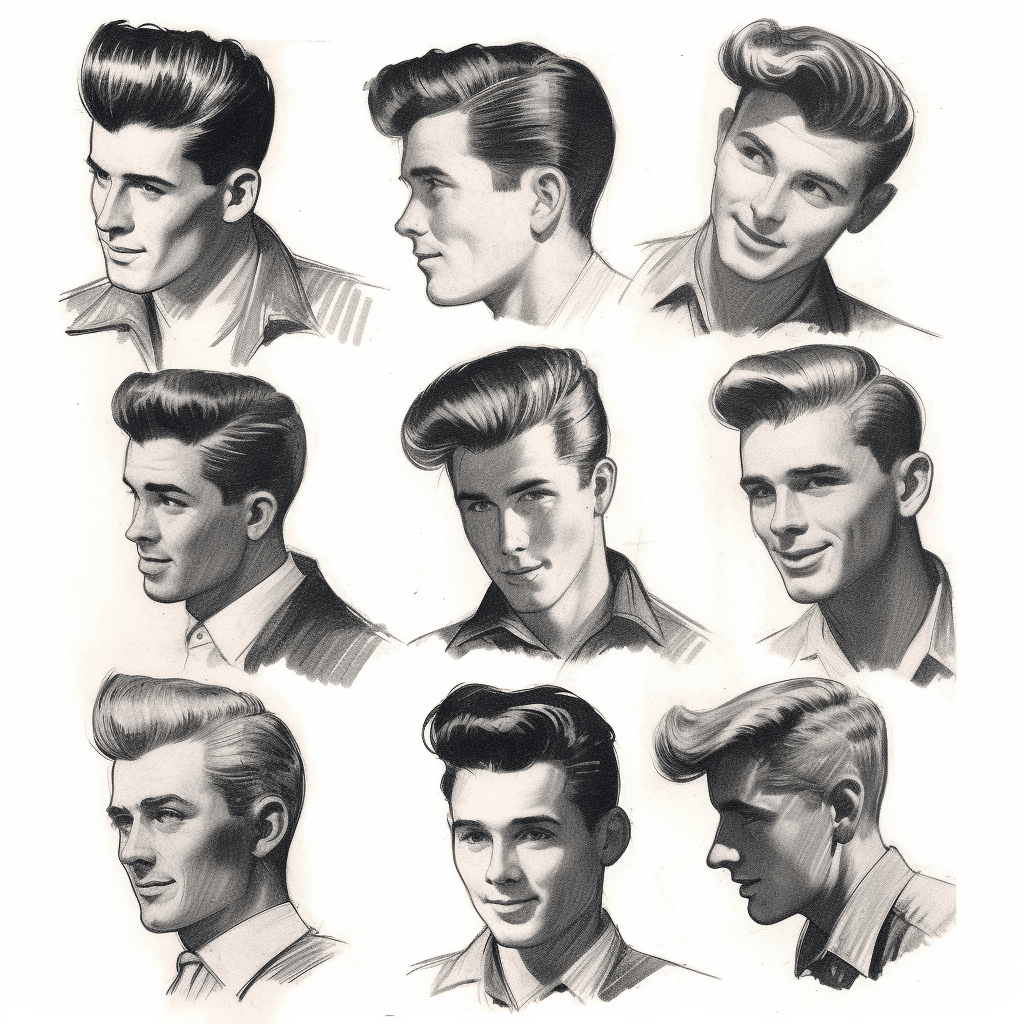
We’ll take a look at 10 of the most popular or considered the best 1950s hairstyles for men and how most of them are still on trend. Old is gold!
Side Part Hairstyle
The most basic or, let’s say most traditional of men’s hairstyles. It is and will remain in trend all the time. Invented back around the 1930s this haircut instantly became the most popular men’s hairstyle from the 50s decade due to the minimal efforts required to pull it off. Every man once in his lifetime has pulled off this hairstyle. By just applying a serum and with the help of a wide-tooth comb this look is achievable very easily and gives you a fresh appearance instantly. If you’re running out of time or in a lazy mood, go with this hairstyle dude!
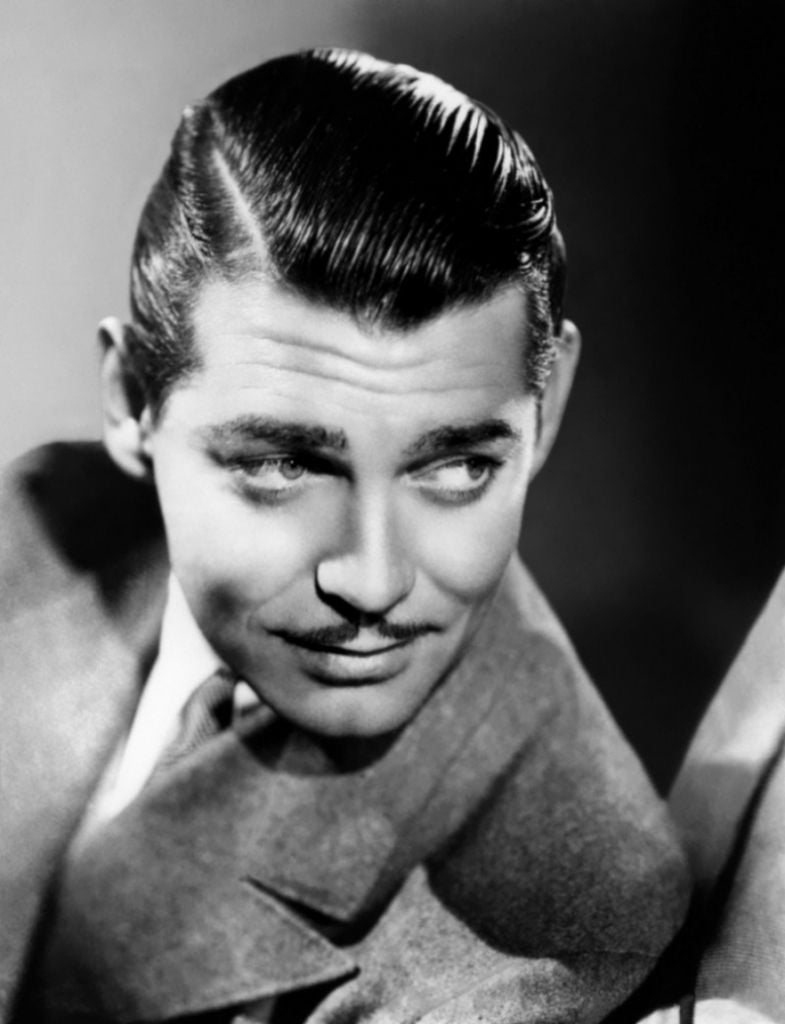
The Slick Back
It should be renamed as sick slick back as it gives you that badass attractive look instantly. You have to let your hair grow with the time and then brush it back to achieve a perfect slick back. If your hair is sort of thick and it doesn’t hold back that well, you should try a new-generation hair gel. It will give you a strong hold without drying your hair. The length of hair may vary, you can have shorter hair for a clean look or a long slick back to spice it up more with an edgier look. Most of the celebrities around the 1950s to this date pull off a slick back hairstyle making it an evergreen hairstyle
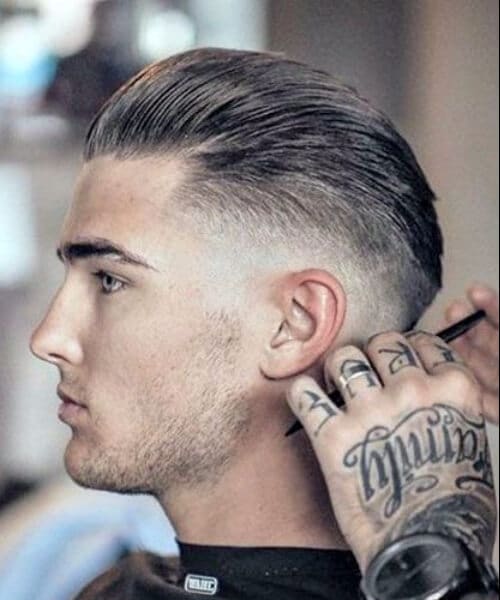
The Rockabilly
The rockabilly aesthetic is another 1950s look started by celebrities like Elvis Presley and James Dean. It is also known as greaser’s hair as our hair needs to be greasier with volume to attain this hairstyle. Rockabilly goes into a more Hollywood or a fancy version of the slick back and pompadours variants. We will need more effort and volume in our hair to achieve this look. A good sculpting clay or hair wax would be needed with a proper blow-dry. The rockabilly has evolved over-time and, still today, it comes as one of the sexiest hairstyles for men.
As the years have passed, the rockabilly style has evolved and continued to make its mark in the world of men’s grooming. Even today, it remains one of the sexiest and enduring hairstyles for men. The appeal of rockabilly lies in its timeless charm and adaptability. This iconic style has left an indelible impact on subsequent generations, influencing fashion and grooming trends far beyond the 1950s.
The fusion of classic elements and modern sensibilities has allowed the rockabilly look to stand the test of time, reminding us that true style never truly goes out of fashion. Whether you’re channeling the 1950s, the rebellious spirit of the greasers, or embracing a contemporary take on rockabilly, this iconic hairstyle continues to captivate and inspire.
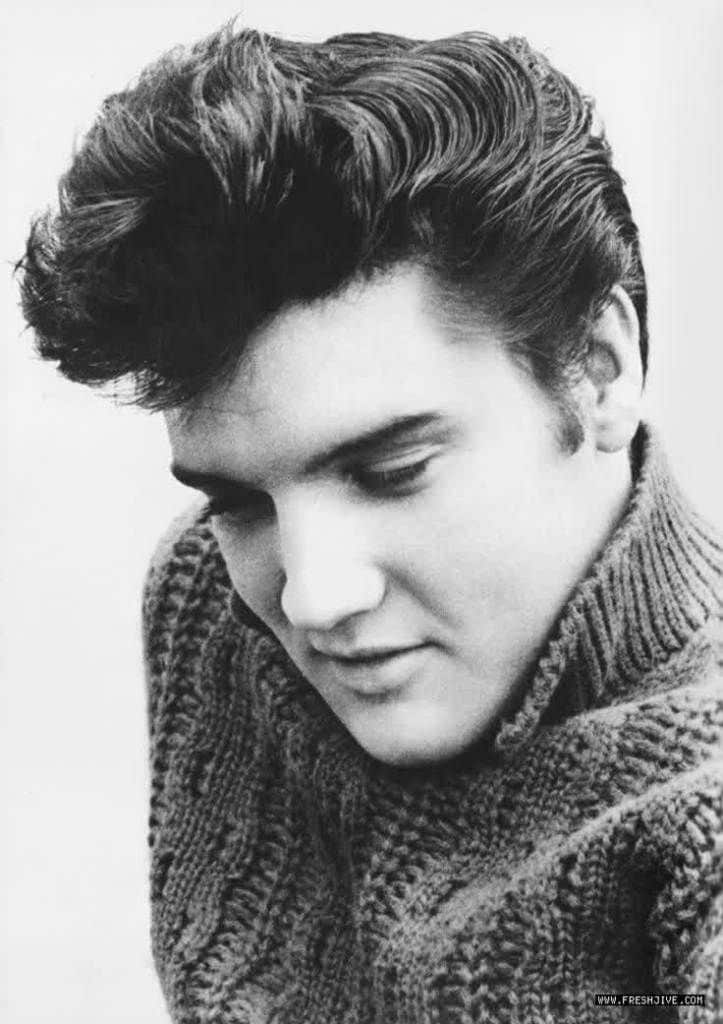
Fringe (Textured or Faded)
The best part about men’s hairstyles in the 1950s was that there was something for everyone. Whatever the texture or length of your hair was. It was easy to attain a look and attitude by adjusting your hair.
If you have bangs that cover your forehead and you decide to shave off your sides it gives you a stylish faded fringe aka French cut. The bangs give you a lot of freedom and allow you to play messier. Add texture to the top of your hair and you got a textured fringe. As simple as that. This fringe look is also a really popular millennial eboy hairstyle.
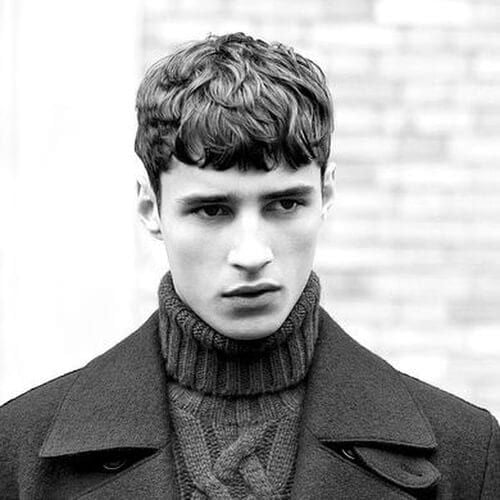
The Pompadour
Arguably considered the king of men’s hairstyle, the pompadour cut was perhaps the greatest invention in the 1950s era of men’s haircuts. Actually, the pompadour was first invented for females, adapted and popularized later by several stars like Elvis Presley, Tony Curtis, David Beckham, etc. The style has been around for a long time and I bet it isn’t going anywhere in the near future. The length required for this haircut should be medium to long, and you have to use proper hair products to achieve some volume. Low fade, skin fade, or long sides. You have lots of options to go with this hairstyle.

The Scissor Cut
Another haircut that is been around for almost 100 years. Invented back in the 1920s, this hairstyle is just another regular combover with no volume or hair styling involved. This remains the most sought-after haircut from 1950s hairstyles for men as it helps to maintain a clean and fresh look. This is highly recommended for job interviews or board meetings where you want to give out a perfect first impression and look damn neat and presentable. There’s always room for experiments if you want to vary hair length with sides and on the top. Make sure you keep it properly conditioned with a silicone-free daily conditioner.
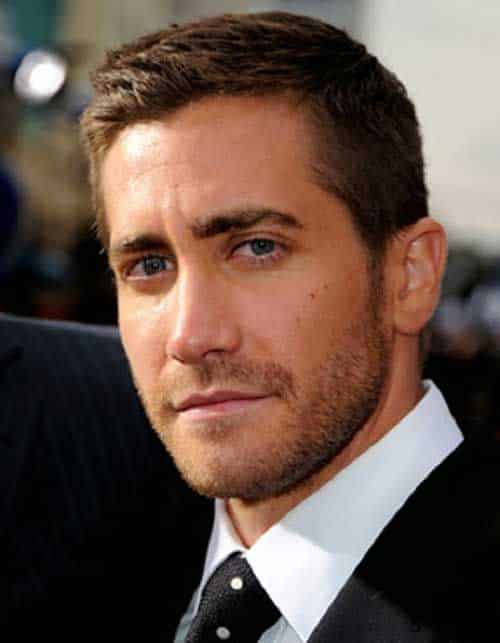
Short & Curly Waves
Men’s hair in the 1950s was often very sleek and straight but it was also curly. This look goes so well with this chic retro style. This hairstyle is a natural gift of God for guys with curly hair. Through slicing the hair sides up to the ear, create a center piece and use a peak and strong hold hairspray to work the hair up and out to produce the two curling “waves.” Make sure to get a good hair primer for low-effort grooming. It will help you work through your hair much smoothly.
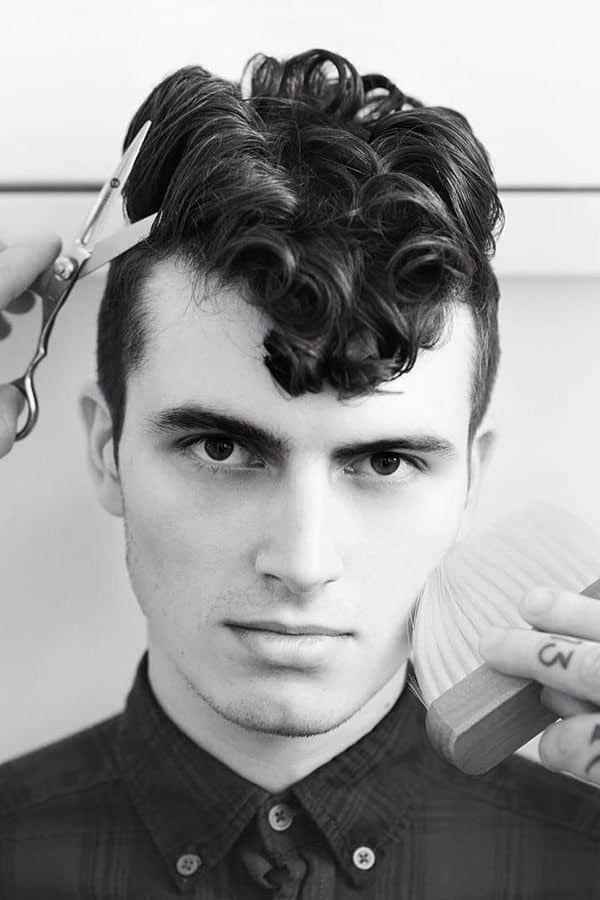
Modern Buzzcut
The buzz cut goes way back to the 1930s, introduced as a uniform military haircut in America in the late 1930s during World War 2. Probably the most masculine cut of all the 1950s Men’s hairstyle era. If you always rock a long or wavy hair and then all of a sudden you go to a buzz cut, you’re going to turn some heads. Another aspect of the buzz cut is that it’s low-maintenance because it doesn’t really need much attention. This is the haircut that saves you most of the time and money. Even though it is short, make sure your scalp is in good condition with a weekly detox and scalp treatment.

The Retro Quiff
A variant of the pompadour, the quiff is a bit wavier in nature as it allows your hair to fall on its natural side. Invented in the 1960s – 1970s, the quiff hairstyle still makes it to the list of 1950s men’s hair trends because it’s a variant of pompadour. The quiff can be rocked on any occasion may it be casual or formal. And if you rock a suit with it, BANG!! I bet you will get some eyes. If you could add some waves using a soft product for texture, you’ll be good to go.
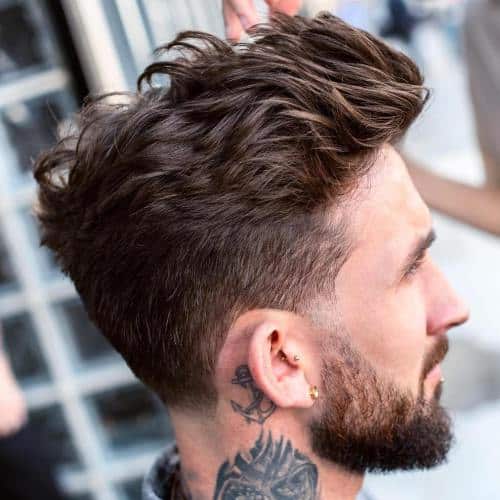
The Ivy League Haircut
The popular men’s haircut of the 1950s era was originally introduced around the late 50s in a pomade ad. The Ivy League haircut is carried by having short and trimmed hair and that makes a curve of hairline on the forehead. The old Ivy League cut was kept short and convertible as of whole but modern changes have given us to experiment more as shorter sides or temper fades, etc. Carried out by actors and celebrities like Matt Damon, Ryan Reynolds… This haircut is last on our list of 1950s hairstyles for men but definitely, it’s not the least.

Our 1950s hairstyles can be rocked even today for any dude. By rocking any one of these you will ensure that your style-game is strong.
The Enduring Influence of 1950s Men’s Hairstyles
The hairstyles of the 1950s were not just about aesthetics; they were emblematic of broader societal changes. The decade marked a move away from the conservative styles of earlier years, embracing more flamboyant and expressive forms of personal style. This era laid the foundation for what would become staple expressions of individuality in men’s fashion.
Styling Tips for Classic 1950s Looks
Maintaining the Classic Slick Back and Side Part: While the original 1950s styles did not have the benefit of modern haircare technology, today’s grooming products can recreate these looks with greater ease and hold. For the classic slick back, opt for a high-quality pomade that offers shine without stiffness. For the ever-popular side part, use a lighter gel or mousse to maintain a clean but flexible hold.
Rockabilly Revival: To achieve the perfect rockabilly style—a look that demands volume and attitude—start with a volumizing wash. Apply a heat protectant before blow-drying your hair to achieve the necessary lift at the roots. Use a strong-hold wax to sculpt your hair into the classic pomp or a more exaggerated jelly roll, ensuring your style holds throughout the day.
Evolution of 1950s Hairstyles into Modern Trends
Many of the most iconic 1950s hairstyles have evolved but continue to influence modern fashion. The pompadour, for instance, has seen various iterations in both men’s and women’s fashion, adapting through the decades but always maintaining its voluminous crown. Similarly, the textured fringe has morphed into today’s textured crops, which are popular in contemporary men’s hairstyling.
Rockabilly to Modern Day: The rockabilly look has seamlessly transitioned into modern subcultures, merging with alternative fashion trends to remain a symbol of edginess and cool. Today, it’s not just about the hair but the entire ensemble that channels a retro vibe with a modern twist.
Certainly! Here’s a list of the top 10 male style and fashion icons from the 1950s, who not only influenced the trends of their era but whose impact on fashion and style remains evident today.
Top 10 1950s Male Style and Fashion Icons
1. James Dean
Known for his rebellious spirit and brooding charisma, James Dean epitomized the cool and effortless style of the 1950s with his iconic leather jacket, white t-shirt, and jeans combo.
2. Elvis Presley
The “King of Rock and Roll” brought a bold, flamboyant flair to 1950s fashion with his sequined outfits, flashy accessories, and, of course, his revolutionary hairstyles like the pompadour.
3. Marlon Brando
Marlon Brando’s portrayal of Johnny Strabler in The Wild One popularized the biker jacket, making it a symbol of rugged masculinity that has lasted through the decades.
4. Cary Grant
The epitome of the classic Hollywood leading man, Cary Grant was admired for his timeless and sophisticated style, often seen in impeccably tailored suits that defined men’s formal wear.
5. Frank Sinatra
Frank Sinatra brought his own brand of cool to the 1950s, often seen in sharp suits and fedoras, which became synonymous with his suave and smooth personality.
6. Tony Curtis
Known for his dark, slicked-back hair and matinee idol looks, Tony Curtis influenced men’s fashion with his sharp suits and the bold choices in evening wear, often incorporating luxurious fabrics and colors.
7. Sidney Poitier
Breaking barriers with his elegance and grace, Sidney Poitier’s style on and off-screen showcased the sophistication of well-fitted suits paired with his powerful presence and professionalism.
8. Gene Kelly
An icon in the world of dance and film, Gene Kelly sported athletic yet stylish outfits that allowed him to move freely, blending functionality with fashion in a way that was ahead of his time.
9. Paul Newman
Emerging in the late 1950s, Paul Newman brought a fresh-faced look to Hollywood fashion. His Ivy League style of casual wear, including polo shirts and chinos, became a standard for laid-back, classic American style.
10. Jack Kerouac
As a figurehead of the Beat Generation, Jack Kerouac influenced fashion with his non-conformist approach to life and style, often seen in simple, rugged outfits that reflected his bohemian lifestyle.
These icons not only shaped the fashion of their time but also left a legacy that continues to influence style today. Their distinct looks and personalities offer a vivid snapshot of 1950s male fashion, from the polished to the rebellious.
Given the keywords from your SEO tool, I will create an extension for the existing article on Men’s 1950s hairstyles. This extension will feature a curated list of the top 5 all-time 1950s men’s hairstyles, followed by a discussion of their cultural impact, evolution, and connection to the rockabilly movement, using your provided keywords.
Beyond the Pompadour: 5 Lesser-Known 1950s Hairstyles That Made History
- The Hollywoodian
Before the full beard became popular, the Hollywoodian style was the go-to for many actors seeking a rugged yet polished appearance. This look involves growing facial hair more extensively along the jawline and chin, paired with a neatly groomed mustache, often accompanied by a hairstyle that is slicked back or parted to enhance the debonair vibe. - The Ducktail
Also known as the “D.A.” (Duck’s Ass), this style requires the hair at the back to be slicked back towards the middle, then parted with a comb down the center. The ducktail was a hallmark of 1950s bad boys and remains a classic representation of the era. - The Elephant Trunk
This style is a variation of the pompadour and part of the rockabilly family. It features a large, voluminous curl that droops down over the forehead, resembling an elephant’s trunk. It was a showstopper then and adds a playful twist to any contemporary look. - The Flat Top
In a variation of the crew cut, the flat top features hair cut into a flat, even layer across the top. This style was a staple among military personnel and athletes during the 50s for its neat, precise appearance. - The Jelly Roll
This style involves rolling the hair away from the face, creating a loop around the forehead. A signature look of rockabilly fashion, it captures the playful and edgy vibe of the 1950s.